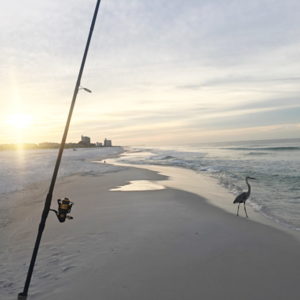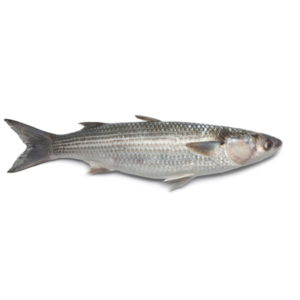*As an Amazon Associate I earn from qualifying purchases.

Pompano and whiting are the two primary species you’ll successfully target from Alabama beaches. However, there is a whole host of other interesting species you can also catch in the surf, such as redfish, Spanish mackerel, bluefish, and sharks, among others.
If you’re new to the area, you might actually be surprised what all fish you can catch in Gulf Shores. I’ve actually had some beach days that were better than some of the expensive deep sea charter trips I’ve been on.
All fish listed here can be caught all along the Alabama coastline, from Dauphin Island to Orange Beach, and everywhere in between.
1. Pompano
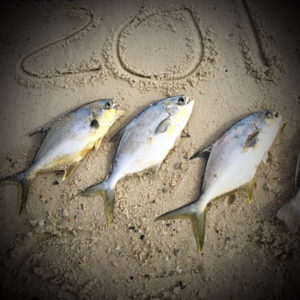
First up is the Florida pompano, which is probably the most prized fish from Gulf Shores beaches. That’s for good reason, as they are one of the best tasting fish in the sea, and they fight extremely hard for their size. Pompano are primarily bottom feeders, seeking out crustaceans in the sand. Their favorite food is the sand flea, aka mole crab, but they’ll also feast on shrimp, small fish, and other small crabs.
Florida pompano are a migratory schooling fish that makes their way along Gulf Shores beaches in greatest concentrations during the spring, but they’ll pass back through in the fall, albeit in smaller concentrations. Although the majority of these fish will migrate through, it is possible to catch them year round.
How To Catch
To catch pompano, focus your efforts in the early springtime through early summer, and use sand fleas if you can find them. To catch sand fleas, it’s best to use a sand flea rake, which can be obtained in tackle shops local to the beach. Even Wal-marts near the beach will usually have rakes in stock.
There are plenty of Youtube videos showing you how to catch sand fleas with a rake. If they’re around, sandfleas are not usually hard to catch.
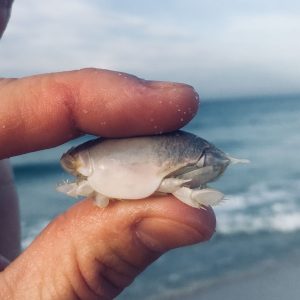
You should always take a backup bait to the beach, so that you aren’t entirely reliant upon finding sand crabs. I like to bring fresh dead shrimp and Fishbites, as those are also excellent pompano baits. Another option are banana jigs, also known as pompano jigs, also known as Goofy jigs. Goofy jigs are really just colored lead molded around a hook in a particular shape. They are the best lure option for pomps.
Best Baits
- Sand Fleas, Mole Crabs
- Fishbites
- Fresh Dead Shrimp
- Goofy Jigs, Banana Jigs
My typical setup would be to use 2 or more rods with 2 hook pompano rigs on each. On those rigs, I use a mixture of baits and colors until I hone in on a preference for the day. You can use sand fleas, shrimp, and various colors of Fishbites to find what they prefer on a given day.
When casting out, you’ll need to try close, medium and far. Don’t be scared to toss a rod out very close to the beach, as in low light situations they’ll sometimes be running very close to the beach.
Alabama has a 3 per person limit on pompano, with a 12″ total length restriction.
2. Whiting
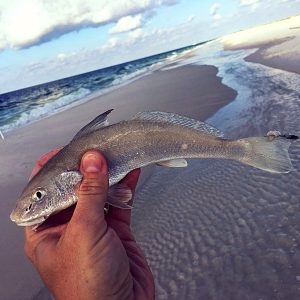
Whiting, or “kingfish”, are extremely common along Gulf Shores beaches, and they are very easy to catch. These whiting are actually 3 different species – Southern, Northern and Gulf kingfish. You’ll most commonly encounter the Gulf kingfish and the Southern kingfish, but you could run across a Northern as well. All 3 species are great eating fish, and there is no size limit in the state of Alabama.
Whiting have a sort of triangular shaped body, and are generally not difficult to identify.
How To Catch
Whiting are predominantly a bottom feeding fish, so you’ll need to put baits on or near the bottom. I find that 2 hook pompano rigs will catch whiting just fine. I would consider possibly downsizing the hooks a bit, if you find that pompano don’t seem to be around anyway. For pompano, I like a 1/0 circle hook, but I might would go down to a #1 or smaller hook when specifically targeting whiting.
Just like pomps, whiting like small crabs, such as sand fleas, and bits of fresh shrimp. Those are the two baits I use, in addition to pieces of Fishbites. Peeling your bite sized pieces of shrimp before putting them on the hook makes an even better bait for whiting.
Best Baits
- Small pieces of shrimp
- Sandfleas
- Fishbites
You’ll find whiting hanging out in the guts off the beach. Start out fishing in the first trough off the beach, as that’s where you’ll often find plenty of them hanging out. If necessary, cast further and further out until you locate where they are holding.
You won’t need any special tackle of any sort to catch whiting. As long as you use small hooks with small fresh baits, you should have no problem getting into some whiting action
3. Redfish
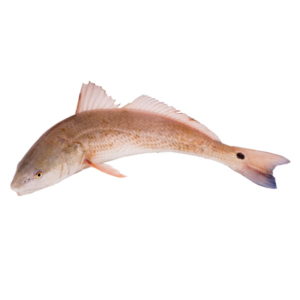
Redfish are one of the most popular saltwater fish pursued in the entire Gulf Coast region. Although they are typically thought of as an inshore species, they can be caught in the surf as well. They fight hard, and the smaller ones, that fall within the slot, are great eating.
What redfish really offer to beach anglers is a realistic chance to catch a giant fish. When bull reds are running in the surf, you have a legitimate chance to catch a 40 to 50 inch fish.
The running of the bulls is a seasonal affair, with the best fishing around Gulf Shores starting in the fall and lasting into early winter (Oct, Nov and Dec). They move close to shore to feed on schools of mullet and menhaden. Fort Morgan is a well known area for large bull red fishing. All the beaches closer to passes are going to be more productive.
The slot for redfish in Alabama is 16-26″, and you can keep 3 in that size range. Alabama also allows 1 of those 3 to be over the slot size, but I don’t recommend keeping large red drum.
How To Catch
There are many ways to catch redfish, as they are typically very ravenous feeders. Blue crab, shrimp, and cut fish, especially mullet heads, are all great bait options. You can also catch redfish on lures, including gold spoons, plastic grubs and topwaters, among others.
Best Baits
- Blue Crab
- Cut Mullet
- Menhaden Chunks
- Cut Ladyfish
The standard fish finder rig, or Carolina rig, works well for redfish. You’ll need a selection of pyramid sinkers from 2 to 6 oz. to pin your bait to the bottom. It just depends on how strong the current is when and where you are fishing. With such a heavy payload, it’s best to have a pretty stout rod capable of casting that much weight. If you don’t have a rod capable of casting a ton of weight, one thing you can do is use a lighter weight Sputnik sinker, or spider weight. That will allow you to downsize your sinker weight and still get good bottom holding capacity.
If you’re having problems with a lot of trash fish eating your baits, you can fish with straight Fishbites, which reds will readily hit. You’ve probably begun to notice a trend here, which is to always take Fishbites as a backup bait!
Although you can do well fishing for bull reds at night, you will run into more sharks after dark. So, if you want to minimize pickups from sharks, you should focus your efforts to daytime hours.
4. Speckled Trout
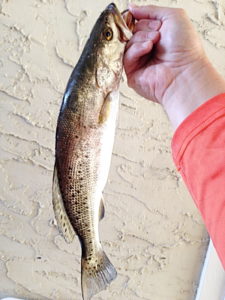
Speckled trout, or spotted seatrout, are another inshore species that you can actually catch in the surf as well. Much like reds, fall is also a great time to encounter specks in the surf. They can be caught year round, but spring and fall are the best times.
Speckled trout are a great eating fish, and you are allowed to keep 6 of them in Alabama. They typically range from 1 to 3 lbs, and must be 15-22″ in total length to keep. In Alabama, you are allowed to have one of the fish in your limit to go over 22″.
How To Catch
Specks are very active fighters, and are a lot of fun on light tackle. All you need is a similar setup as you would normally use for bass fishing, whether that be spinning or conventional. Light line is good but you need a bit of a heavy leader as speckled trout will cut through light mono. 20 to 30 lb monofilament or fluorocarbon leader will do the trick.
Best Baits
- Live Shrimp
- Soft Plastics
- Jerkbaits
- Topwaters
Live bait, lures and fresh dead bait all work good for speckled trout. Using a shrimp or plastic lure in combination with a popping cork is a great method for catching trout. There are also many other ways to catch them using various lures such as jerkbaits, walk the dog topwaters, jigs, shrimp imitators and various soft plastics.
5. Black Drum

Black drum are close cousins to the redfish, or red drum. Like redfish, black drum are another species that give you a chance to catch a giant from Gulf Shores beaches. They commonly reach weights of 30 to 50 pounds in this area. Although they don’t fight as hard as bull reds, these “big uglies” are still very fun to catch.
Smaller black drum have vertical bars, as shown above, similar to a sheepshead. That is about the only fish they could be confused with. The differentiating characteristics are the barbels located under a black drum’s chin, and the lack of human like teeth found on sheepshead.
Black drum are a good tasting fish when young, but the huge black drums should be released as they have worms and tough meat.
How To Catch
Black drum have smaller mouths than their redfish cousins, so you will need to use smaller baits than you might use to catch big bull reds. So, instead of using a whole blue crab, for instance, you might cut it in half or quarter sized pieces.
Black drum prefer all types of crustaceans, shrimp and cut baits, especially mullet. A fish finder rig, or Carolina rig, works well to keep your bait on the bottom where you will encounter these fish.
Best Baits
- Blue Crab Pieces
- Shrimp
- Cut Fish
6. Spanish Mackerel

Spanish mackerel from 1 to 3 lbs are common to the Gulf Shores area. The meat is darker with a richer taste, and might taste different than what you’re used to. I personally like them just fine. They are a fast swimming pelagic fish that are great fun on light tackle.
You have to take care not to confuse a Spanish mackerel with a baby king mackerel, which would be illegal to harvest. The spots of a Spanish mackerel are a more brightly colored yellow, and are more round in shape. The true way to differentiate between the two is the lateral line. The lateral line gradually tapers toward the back on a Spanish, whereas Kings have a sharp dip in the lateral line.
Alabama allows you to keep up to 15 of any size Spanish you like, so this is a good fish to target for a nice family meal back at the condo.
How To Catch
Spanish are more of a target of opportunity when fishing from the beach. I like to have an extra rod rigged up, and on the ready for when I see a school of feeding fish making their way down the beach. The school could be ladyfish, bluefish, Spanish, or some mixture of a couple different species.
I like targeting passing schools with flashy, quick moving lures, such as spoons and Gotcha plugs. When the water is clear, Spanish will move in close to the beach, where you can reach them with heavy lures. The key is to move your lure very fast. You won’t be able to outpace these speedsters.
Best Baits
- Spoons
- Gotcha Plugs
- Shrimp
- Bubble Rigs
- Jigs
- Small Live Baitfish
7. Bluefish

We don’t typically get large bluefish along the Northern Gulf Coast, but the ones we do get are sure fun to catch. Much like Spanish mackerel, blues are more of a target of opportunity if you happen upon a busting school of fish in the surf.
Around Gulf Shores, and surrounding waters, they’ll typically only be 1-3 lbs, but can get bigger – 2 to 3 times that size on occasion. A 15 pounder is a stud, but those are infrequent in Alabama.
Bluefish actually are OK to eat if prepared while still very fresh. I don’t personally keep bluefish, as there are better fish out there, if you’re looking for a nice meal. There is no size restriction on bluefish in the state of Alabama.
How To Catch
Bluefish have a toothy mouth, so you’ll need a heavy monofilament leader to battle with them. They will hit all the common natural baits used for surf fishing, such as live shrimp, cut bait, and squid. Therefore, you will sometimes catch them on your pompano rigs or other rigs as a by-catch.
I target bluefish the same way I do Spanish, with fast moving artificials when a school gets near. Krocodile spoons and Hopkins spoons both work really well for casting to bluefish.
When you catch a bluefish, be sure to grasp them firmly as they can administer a nasty bite if you aren’t careful.
Best Baits
- Shrimp
- Cut Bait
- Squid
- Spoons
- Jigs
- Topwaters
8. Sharks (Blacktips)
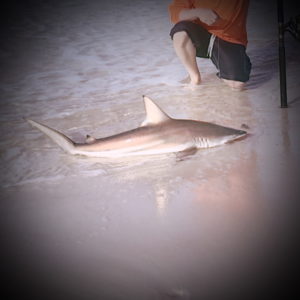
Anytime you’re soaking baits on the bottom for bull reds or black drum in Gulf Shores, you’re eventually going to encounter the local shark population. While sharks are certainly fun to catch, they can become a nuisance. Larger ones will commonly bite your leaders off before you can actually get them in.
With specialized gear, such as large reels and steel leaders, you can fight these larger sharks onto the sand. However, you should know that Alabama has more stringent regulations than surrounding states when it comes to specifically targeting sharks from the beach. So, if you want to deliberately target sharks, you’ll need to familiarize yourself with the Alabama restrictions.
My interpretation of the Alabama law (Rule 220-2-.42) is that you can probably target them, as long as there are no beach goers around. To do so, you could either fish at night, or you could head to a more secluded area where there are no beach goers around. Basically, you are required to NOT create an unsafe condition for others. Since this is rather ambiguous, you’ll need to use your own judgement of what that means. You can find the regulations discussed here, and make up your own mind.
How To Catch
You can fish for small sharks with the same rig as you would normally use for bull reds. Anything beyond that would be fairly specialized, and out of the context of this article. I do have an article specifically dedicated to this topic if you are interested: Catch Sharks By Casting Baits From The Beach
If in doubt, you could always purchase a Florida saltwater license, and shark fish all you want across the state line. Florida has it’s own regulations that you would need to abide by, but Florida is generally more shark friendly when fishing from the beach.
Best Baits
- Chunks of Bonita
- Cut Ladyfish
- Stingray Pieces
- Most any cut fish you can find in the surf
9. Catfish

If coming from a freshwater fishing background, it might seem strange to know that catfish are extremely common in the surf as well. There are actually 2 different species of catfish common to Gulf Shores beaches. Most prevalent is the much hated hardhead catfish. Sometimes these run so thick it feels impossible to catch anything else. There is also the gafftopsail catfish, which is a much better eating fish, and generally larger and more sporting as well.
How To Catch
If anything, you’ll normally be trying to avoid catfish, rather than catch them. One way to minimize the onslaught of catfish on your baits is to use Fishbites. Desirable fish seem to like Fishbites more than the undesirables do. While that’s not 100%, it does help. You could also attempt to relocate to a section of beach with clearer water, or go on a day when there is clearer water to be found. The catfish seem to love dirty surf.
10. Flounder

There are 2 different species of flounder that you may run across on Gulf Shores and surrounding beaches. The Gulf flounder and the Southern flounder are both possible catches, with the Gulf flounder being the smaller, and more common of the 2. Flounder make for excellent table fare, so you may want to keep any that are large enough. You can expect a keeper flounder to weight from 1 to 3 lbs, and they must be at least 14″ total length in Alabama.
How To Catch
Flounder don’t tend to swim around to hunt for food. Instead, they lie in wait in order to ambush their prey as it passes by. Therefore, you’ll need to move your bait around until you find the fish.
The best bait for flounder is live bull minnows, but lures and various other baits will work as well. Live shrimp, finger mullet, Gulp baits, plastic jigs, plastic shrimp, and bucktails are all excellent choices. It’s best to use light tackle and bounce your bait along the bottom. Focus your efforts for flounder in the fall when they will leave inshore waters to spawn offshore.
Best Baits
- Live Bull Minnows
- Live Shrimp
- Finger Mullet
- Gulp Baits
- Plastic Jigs
- Bucktails
11. Stingray
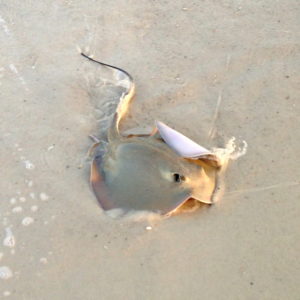
It’s inevitable that you’ll eventually catch a stingray when fishing from the beach with natural baits. Unless they are searching for shark bait, most anglers don’t actually intend to hook a stingray.
The shape of a stingray actually creates quite a bit of resistance in the water. So, while they’re not strong fighters, they do provide something fun to tug on, especially when the bite is slow.
How To Catch
Stingrays will hit many of the same rigs and natural baits you cast out for other species, including shrimp, small crabs, and cut bait. The most stingrays I ever caught in an outing was on chunks of frozen cigar minnows. They couldn’t get enough of them.
You’ll need to be extremely careful not to get pierced by the barb when unhooking them. I have an article here on how to unhook a stingray without getting stung.
12. Ladyfish

While they may be commonly classified as a trash fish, ladyfish are actually quite fun to catch. When hooked, they have a sort of scaled down version of the acrobatics common to their larger cousin, the tarpon. These hard fighting leapers are often a welcome recourse when the fishing is slow.
Ladyfish, or “skipjack”, also make great cut bait for several of the other species listed here, such as redfish and sharks.
How To Catch
These “poor man’s tarpon” are quite easy to catch when they’re around. Any bait that mimics a small silver fish, such as a silver spoon, will gain plenty of interest from surrounding schools of ladyfish. They’ll also hit all manner of baits that you might normally add to your pompano rigs.
Be aware that larger ladies can cut through thin monofilament lines, so you might need to increase your leader strength if you keep getting bit off.
Best Baits
- Silver Spoons
- Any fast moving small fish imitating lure
Other Possible Catches
There are tons of other species that you might wander upon while fishing on, or near Gulf Shores beaches. This is what makes surf fishing so interesting to me, compared to freshwater pursuits. You really don’t ever know what you might hook in to. Below is anther short list of additional fish that you may catch on the Alabama coast.
- Croaker
- White Trout
- Mullet
- Spadefish
- Mangrove Snapper
- Sheepshead
- Cownose Ray
- Needlefish
- Remora
- Jack Crevalle
- Blue Runner aka Hard-tail Jack
- Pinfish
Conclusion
These are but just a few of the species you’ll encounter when fishing the pristine beaches of Gulf Shores and the surrounding area. With a little preparation and knowledge, you’ll most certainly be successful at targeting the fish listed above.
I find the key to consistent success is to stick with fresh bait, not frozen. So, head over to J&M Tackle in Orange Beach to get some, and get after them.
For more details on how to get started, here’s a few other articles from my site that will guide you in the right direction.
How To Go Surf Fishing On A Family Beach Vacation
How To Catch Pompano From The Surf
Surf Fishing Supply List For Beginners
Good Luck!
Augustus Clay

